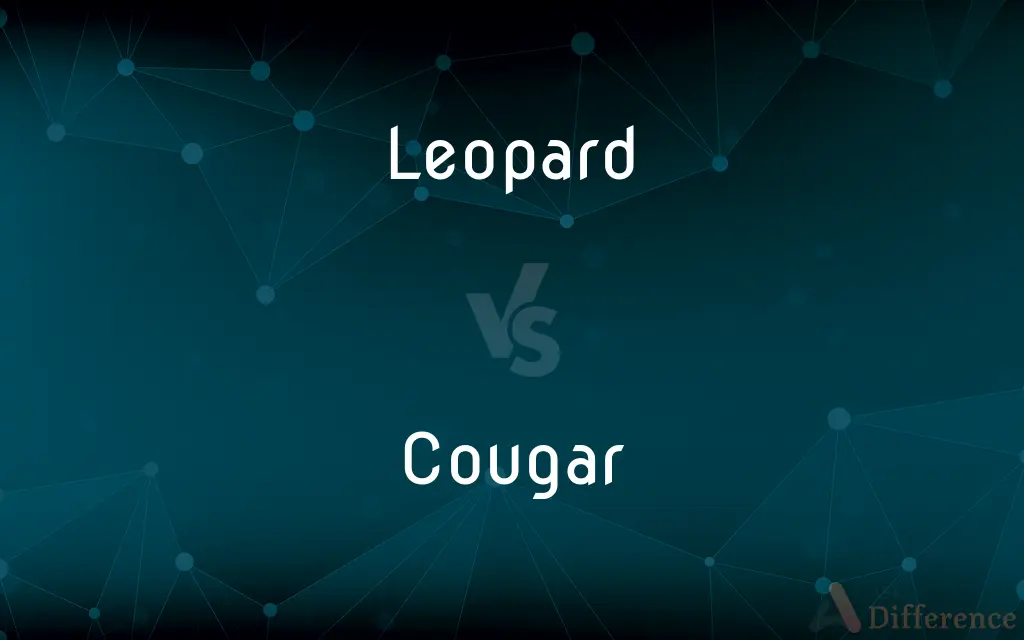Leopard vs. Cougar — What's the Difference?
By Fiza Rafique & Urooj Arif — Updated on April 4, 2024
Leopards are large, spotted cats native to Africa and parts of Asia, known for their adaptability and climbing ability, whereas cougars, also known as mountain lions, are native to the Americas and recognized for their size, strength, and agility.

Difference Between Leopard and Cougar
Table of Contents
ADVERTISEMENT
Key Differences
Leopards are distinguished by their rosette-patterned coat, which provides camouflage in their natural habitats, ranging from dense bush to forests. This distinctive pattern is crucial for their hunting and stealth tactics. Cougars, on the other hand, have a uniform tan or slightly yellow coat, better suited to their environments, which include mountains, forests, and deserts. The absence of spots or rosettes in cougars helps them blend into a variety of backdrops, from the rocky terrains to the shadowy underbrush.
In terms of behavior, leopards are solitary and highly territorial animals, often dragging their prey up trees to protect it from scavengers. This arboreal tactic is unique among large cats and showcases the leopard's exceptional climbing skills. Cougars, while also solitary and territorial, do not typically use trees for storing prey. They are known for their remarkable jumping ability, capable of leaping vertically up to 18 feet and horizontally over 40 feet, demonstrating their agility and strength in capturing prey or evading threats.
Leopards have a broad diet and are considered one of the most versatile predators, hunting over 90 species of animals. Their diet ranges from small insects to large ungulates, adapting based on their environment and prey availability. Cougars have a more specialized diet, primarily preying on deer, though they can adapt their diet to include smaller animals and livestock depending on their habitat and the availability of prey.
The geographical range of these two species also highlights a significant difference. Leopards are found across a wide range of Africa and parts of Asia, including fragmented populations in India, Southeast Asia, and the Middle East. Cougars have a broad range as well, but they are exclusive to the Americas, from the Canadian Yukon to the southern Andes of South America, making them the most widely distributed large wild terrestrial mammal in the Western Hemisphere.
Despite their differences, both leopards and cougars play a crucial role in their ecosystems as top predators, maintaining the balance by controlling herbivore populations. Their adaptability to various habitats has allowed them to survive in changing environments, though both face threats from habitat loss and human activities.
ADVERTISEMENT
Comparison Chart
Habitat
Africa and parts of Asia
Americas
Coat Pattern
Rosette-patterned
Uniform tan or yellow
Behavior
Solitary, territorial, climbs trees with prey
Solitary, territorial, exceptional jumper
Diet
Over 90 species, very versatile
Primarily deer, but adaptable
Geographical Range
Wide range in Africa and Asia
Americas, from Canada to South America
Compare with Definitions
Leopard
Versatile Predator.
A leopard's diet is diverse, including insects, birds, and large mammals, showcasing its adaptability.
Cougar
Wide Geographical Range.
The cougar's range extends from the Yukon in Canada to the southern Andes, showing its adaptability to different climates.
Leopard
Solitary.
Leopards lead a solitary life, marking their territory with scent marks to avoid encounters with others.
Cougar
Uniform Tan Coat.
The cougar's uniform tan coat helps it blend into its mountainous and forested environments.
Leopard
Endangered in Some Regions.
In parts of its range, the leopard is considered endangered due to habitat loss and poaching.
Cougar
Exceptional Jumper.
Cougars can leap vertically up to 18 feet, demonstrating their powerful leg muscles.
Leopard
Arboreal.
Leopards are known for their ability to climb trees, often hauling their prey up to eat in seclusion.
Cougar
Specialized Diet.
The diet of a cougar is heavily focused on deer, although it can adapt based on availability.
Leopard
Rosette-Patterned Coat.
The leopard's rosette-patterned coat provides excellent camouflage in the dappled light of its forest habitat.
Cougar
Solitary Territorial.
Cougars are solitary creatures, rarely interacting with others except during mating or mothering.
Leopard
The leopard (Panthera pardus) is one of the five extant species in the genus Panthera, a member of the cat family, Felidae. It occurs in a wide range in sub-Saharan Africa, in some parts of Western and Central Asia, Southern Russia, and on the Indian subcontinent to Southeast and East Asia.
Cougar
The cougar (Puma concolor) is a large cat of the subfamily Felinae. Native to the Americas, its range spans from the Canadian Yukon to the southern Andes in South America and is the most widespread of any large wild terrestrial mammal in the Western Hemisphere.
Leopard
A large wild cat (Panthera pardus) of Africa and southern Asia, having either tawny fur with dark rosettelike markings or black fur.
Cougar
A large powerful wild cat (Puma concolor syn. Felis concolor) chiefly of mountainous regions of the Americas, having an unmarked tawny body and a long tail. Also called catamount, mountain cat, mountain lion, panther, puma; Also called regionally painter.
Leopard
Any of several similar felines, such as the cheetah or the snow leopard.
Cougar
(Slang) A woman, especially one over 30, who romantically pursues or attracts younger men.
Leopard
(Heraldry) A lion in side view, having one forepaw raised and the head facing the observer.
Cougar
Puma concolor, a wild feline native to the Americas.
Florida panther
Leopard
Panthera pardus, a large wild cat with a spotted coat native to Africa and Asia, especially the male of the species (in contrast to leopardess).
Cougar
An American feline quadruped (Felis concolor), resembling the African panther in size and habits. Its color is tawny, without spots; hence writers often called it the American lion. Called also puma, panther, mountain lion, and catamount. See Puma.
Leopard
(inexact) A similar-looking, large wild cat named after the leopard.
Cougar
Large American feline resembling a lion
Leopard
The clouded leopard (Neofelis nebulosa), a large wild cat native to Asia.
Leopard
The snow leopard (Panthera uncia), a large wild cat native to Asia.
Leopard
(heraldry) A lion passant guardant.
Leopard
Any of various nymphalid butterflies of the genus Phalanta, having black markings on an orange base.
Leopard
A large, savage, carnivorous mammal (Felis leopardus). It is of a yellow or fawn color, with rings or roselike clusters of black spots along the back and sides. It is found in Southern Asia and Africa. By some the panther (Felis pardus) is regarded as a variety of leopard.
Leopard
The pelt of a leopard
Leopard
Large feline of African and Asian forests usually having a tawny coat with black spots
Common Curiosities
What threats do leopards and cougars face?
Both face threats from habitat loss, human-wildlife conflict, and in some areas, hunting or poaching.
What are the main differences between leopards and cougars?
Key differences include their habitat, coat pattern, dietary habits, and geographical range.
How do the solitary behaviors of leopards and cougars impact their survival?
Solitary behavior helps reduce conflict and competition for resources, crucial for their survival as top predators.
Can leopards and cougars be found in the same habitat?
No, leopards and cougars are native to different continents and do not share the same habitats.
How do leopards and cougars adapt to their environment?
Leopards use their camouflaged coat and climbing ability, while cougars rely on their jumping ability and camouflage.
What role do leopards and cougars play in their ecosystems?
They maintain the balance by controlling herbivore populations, affecting vegetation and other animal populations indirectly.
What adaptations help leopards survive in varied environments?
Their camouflaged coat, climbing ability, and versatile diet contribute to their survival across different habitats.
Are leopards or cougars more versatile in their diet?
Leopards are considered more versatile, with a diet including over 90 species, compared to cougars' more specialized diet.
Can cougars and leopards interbreed?
No, they are different species with significant genetic differences, making interbreeding impossible.
How do humans impact the conservation of these species?
Human activities affect their populations through habitat destruction, climate change, and in some areas, direct persecution.
How can people safely coexist with leopards and cougars?
Through education, implementing protective measures for livestock, and supporting habitat conservation efforts.
Why are leopards considered endangered in some regions?
Due to habitat loss, decreased prey availability, and illegal hunting for their fur and body parts.
Are there any conservation success stories for leopards or cougars?
Yes, conservation efforts, including habitat protection and anti-poaching measures, have helped stabilize some leopard and cougar populations.
What unique challenges do cougars face in the Americas?
Cougars contend with expanding human development, leading to habitat fragmentation and increased conflicts.
How do leopards and cougars communicate?
Both use vocalizations, scent marking, and body language to communicate, especially in territories and during mating seasons.
Share Your Discovery

Previous Comparison
Trepidatiously vs. Trepidly
Next Comparison
Camaieu vs. MonochromeAuthor Spotlight
Written by
Fiza RafiqueFiza Rafique is a skilled content writer at AskDifference.com, where she meticulously refines and enhances written pieces. Drawing from her vast editorial expertise, Fiza ensures clarity, accuracy, and precision in every article. Passionate about language, she continually seeks to elevate the quality of content for readers worldwide.
Co-written by
Urooj ArifUrooj is a skilled content writer at Ask Difference, known for her exceptional ability to simplify complex topics into engaging and informative content. With a passion for research and a flair for clear, concise writing, she consistently delivers articles that resonate with our diverse audience.















































